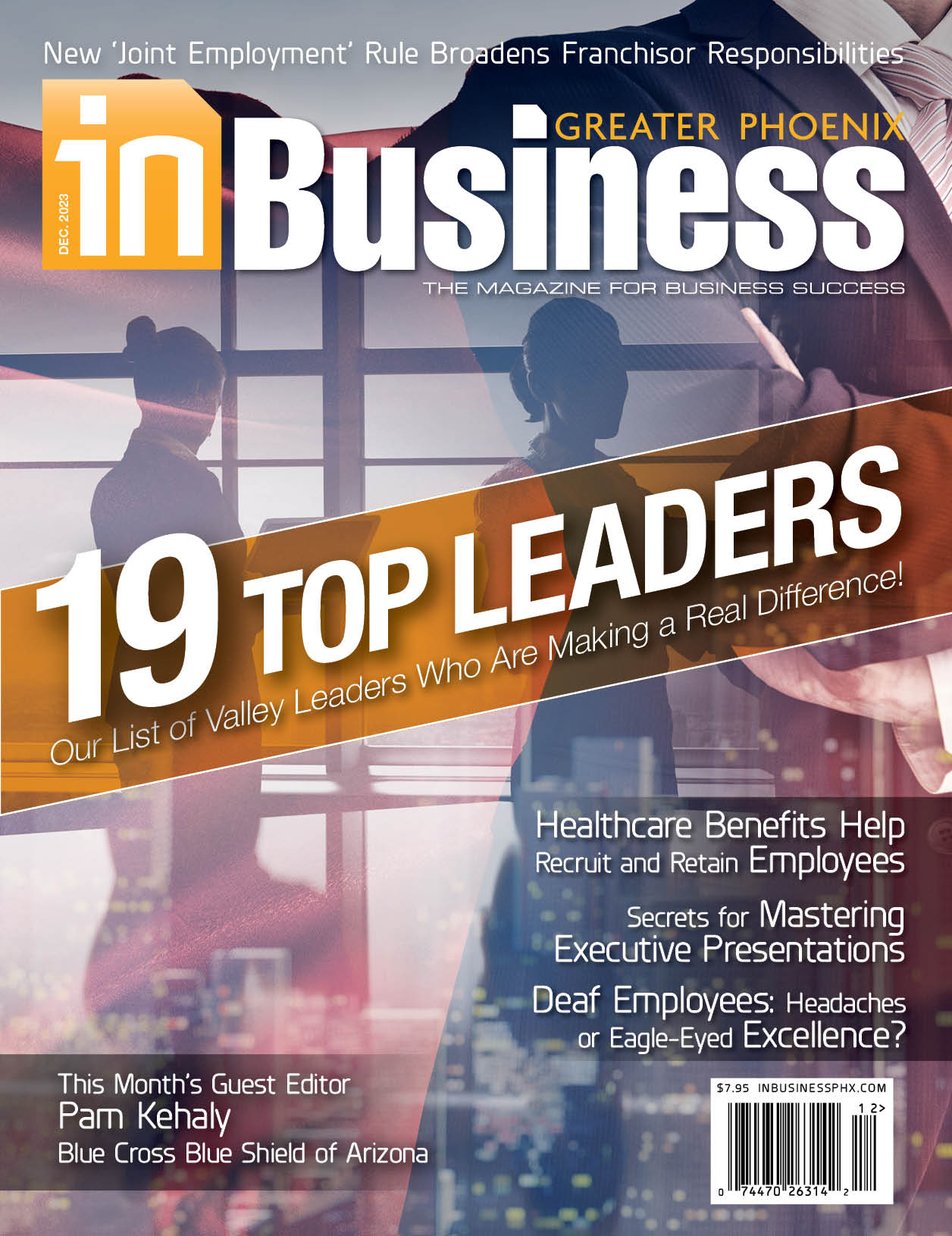
“Aside from a worker shortage, arguably the most significant issue facing employers is mental health,” says Peggy Chase, president and CEO of Terros Health. This reality has forced into the open a topic once too stigmatized to be spoken about.
Arizona ranks 47th in the U.S. for access to mental health care, according to Sandra Zebrowski, M.D., corporate medical director of behavioral health at Blue Cross Blue Shield of Arizona. And the number of adults with frequent mental distress continues to increase — up 29% between 2015 and 2019, as reported in America’s Health Rankings 2020. The same rankings report places Arizona at 27th in the nation for frequent mental distress and 33rd for lives lost to suicide. Significantly, she notes, “These sobering statistics predate COVID-19.”
However, COVID-19 has helped bring discussion of mental health into the mainstream. “As one of the leading health insurance carriers in the state of Arizona, behavioral health has always been a priority for us,” Zebrowski shares, noting that, as COVID-19 began to storm our state, Blue Cross Blue Shield of Arizona began to see more and more inquiries from employers about behavioral health resources.
Chase reports a similar experience at Terros, a healthcare company focused on the whole person that provides primary care and has specialized in mental health and substance use treatment for more than 50 years. “Locally,” she says, “Terros Health has seen a demand for mental health services during the past 16 months, too. This includes visits from individuals who have never had a mental health condition and members of our staff.
“Wellness in the workplace has been gaining traction for some time,” Chase continues. “But until recently, many aspects of mental health — and especially the integration of employees’ physical and emotional well-being — have been largely overlooked. This has happened despite a surge in the number of U.S. adults reporting anxiety, depression and other mental health symptoms — 30% compared with 11% in 2019, according to the Kaiser Family Foundation.” Along with this, she notes there has also been a sharp rise in individuals with substance-use disorders and deaths from drug overdoses.
“The pandemic certainly has contributed to a greater awareness of and emphasis on mental health in the workplace,” says Shawn Ellis, vice president of human resources at Lovitt & Touché, who reports an increase — both internally and with clients — in the number of requests, discussions and programs aimed at improving employees’ mental health and wellbeing. “There is an understanding and recognition that many employees are struggling and need help to ensure they remain healthy, happy and productive.”
The recent attention is arguably long overdue. Whatever the future may bring, Casey Strunk, president of Strunk Insurance Group, believes building resiliency is likely to remain a priority. “Employers are in a unique situation and may be able to champion mental health and well-being in the workplace,” he says, encouraging employers to focus on employees’ mental health needs. “Otherwise, anxiety, fatigue and burnout could further impact employee engagement, productivity and absenteeism.”
As a business owner himself, Rhett Doolittle, CEO of Business Warrior, believes that one of the most important things he can do is put himself in the shoes of every member on his team. “Awareness of mental health is the key,” he says. Noting that his company seeks out formal training in emotional intelligence (EQ), he explains, “If our company as a whole has a high EQ, then it means that everybody is aware of their own emotions and making a concentrated effort to recognize and understand others’ emotions as well. This plays a big part in mental health, but the first step is to just recognize what’s going on with what’s working and what’s not.” His point is that an environment where everyone at the company has an outward focus on others helps them recognize any negative or positive shifts in people’s mental health. “Once we’re aware of a problem or something that is working well, then we can course-correct from there, seek outside help, or just keep doing more of what’s working.”
Paying attention is where Zebrowski says BCBSAZ, too, is placing greater emphasis these days — paying close attention and providing resources for behavioral health issues. “We are living through a period of uncertainty and change, and that’s had a major effect on our everyday lives,” she says, pointing out that, historically, populations who have lived through pandemic events have experienced an increase in behavioral health concerns, substance use and deaths of despair long after the pandemic passes. “At BCBSAZ, we strive to be part of the solution in breaking down the stigma around behavioral health and fostering partnerships that allow easier access to care for our members.”
However, Ellis points out that even as mental health awareness grows among the business community, there is no magic formula or one-size-fits-all approach to addressing the issue. Smaller employers, for example, might not have the resources to pay for and introduce a mental health program as extensive as a larger competitor or businesses in other industries. “But the good news is, there are numerous resources and solutions available that employers can explore to support their employees’ mental health,” she says, suggesting they speak with their benefits provider or insurance broker to see what tools and solutions might work for them.
Accessibility is the issue Mind 24/7 specifically addresses, offering 24/7 walk-in crisis mental health and substance abuse services whenever an individual needs it, regardless of coverage. MIND 24-7 describes its approach as using innovations in value-based care models to improve and expand access to care, not only enhancing the quality of patient care, but reducing pressure on the system, reducing costly emergency room visits, in-patient treatment and readmissions. Says Jeff Spight, CEO and co-founder, “The increased access and focused services MIND 24-7 provides is crucial for the workforce, which has faced extraordinary mental health challenges. Employees spend a large part of their day — and lifetime — at work, increasing the effect that workplace environments can have on psychological well-being and increasing the need for employers to support their employees’ mental health.” He cites recent studies showing that one-fifth of American adults experience a mental illness and 57% of them have their mental health needs unmet.
Increased Stressors on Mental Health
Since the onset of the COVID-19 pandemic, Americans have reported increases in anxiety, depression and thoughts of suicide, Strunk says. Observing that the toll the pandemic takes on mental health increases daily, he points out, “Before the pandemic, 5% of employed workers reported poor or very poor mental health. Now, 18% of employed workers struggle with mental health issues.”
While the reasons for the uptick in mental health conditions are wide-ranging, Chase points out that they include long-term effects of such pandemic-related issues as economic hardships, the fear of losing a job, and balancing remote work and remote schooling for the kids.
In fact, the pandemic has contributed to a host of new stressors and pressures on mental health, observes Ellis. These range from increased feelings of detachment and loneliness to blurred lines between home and work. “For many of our employees who have children and larger families, working from home has been a challenge, especially if they have limited space to find peace and quiet to work,” she says. “Additionally, they are forced to wear multiple hats, like parent, employee and teacher, while never feeling like they have a moment to log out or recharge.” Employees with the opposite home situation reported a surprisingly similar reaction. “Our employees who live alone were most eager to return to the office earlier this year because many felt disconnected and lonely after working from home for so long.”
Stress is coming not just from the pandemic but from returning to work after quarantine, Spight points out. Along with stresses such as isolation, loneliness, financial hardship, housing and food insecurity, interpersonal violence is also common. According to Spight, this has caused a 93% increase in adults seeking help with anxiety and depression. “Yet, tragically, 13.8 million adults have unmet mental health needs because of both cost and available providers.”
Zebrowski cites additional sources that underscore the magnitude of the problem: The Kaiser Family Foundation reports that in January 2021, 41% of adults reported symptoms of anxiety and/or depressive disorder, and in a survey from the CDC, from June 2020, 13% of adults reported new or increased substance use due to coronavirus-related stress and 11% of adults reported thoughts of suicide in the past 30 days.
“Now more than ever, mental health care needs to be normalized and employers should support their employees’ mental health the same way they do physical health,” Spight says, noting it’s not only the right thing to do but also can help businesses be more successful. “Depression and anxiety orders cost the global economy nearly $1 trillion each year in productivity alone,” he says.
“Starting from a positive place in any situation is a great way to improve our personal mental health immediately,” says Doolittle, sharing his view that the place to start is appreciating things everyone in the United States has in common, “like freedom and equality … and a big one that is usually missed: small businesses. Small businesses are a part of what makes the United States unique and amazing, and it’s something that could help bring us together again.”
Doolittle found that going fully remote last year initially gained his company a big increase in productivity, but the extended isolation has turned those results on their head. “The mixture of people being alone more, lots of negativity from the news, and a lack of a common goal as a community is driving people apart and probably a significant factor to people’s mental health right now. We’re working on establishing a mixture of working virtually and having an office or public place to collaborate.”
Programs Address Mental Health
The Mental Health Parity and Addiction Equity Act (known as the federal parity law), enacted in 2008, requires health plans to cover behavioral health services with the same or fewer restrictions than medical services.
Noting that, previously, many employers relied heavily on their employee assistance programs and mental health coverages in healthcare plans when it came to support for employees’ mental health, Ellis says, “Since the pandemic, there’s been a shift from less passive offerings to more active initiatives that seek to meet employees where they are — whether email, mobile apps, push notifications, etc. The emphasis today is much more on directly reaching out to employees and asking, ‘How are you feeling?’ rather than relying on the employee to say, ‘I need help.’”
Zebrowski shares that BCBSAZ has also promoted the evidence-based program Mental Health First Aid class that helps employees learn how to recognize the signs and symptoms that may suggest a potential mental health challenge, how to listen nonjudgmentally and give reassurance to a person who may be experiencing a mental health challenge. Notably, the class works to reduce the stigma of mental health challenges.
“Some of the signs of employees who may be in distress are a sense of withdrawal, a feeling of inadequacy and a change in their quality of work,” shares Chase, also noting there are myriad ways to help. She adds, “Through it all, COVID-19 has underscored the importance of integrated care, particularly as some employees have experienced a sense of isolation amid the transition to a remote workplace.”
Zebrowski reports that BCBSAZ recently partnered with Quartet Health to help make it easier for patients with Blue Cross Blue Shield of Arizona health insurance, in Maricopa County, to quickly connect with mental health care services, including a therapist or psychiatrist. “This partnership extends BCBSAZ’s commitment to improving the health and wellness of all Arizonans, including an important focus on mental health,” she explains. It works through Quartet’s secure, virtual platform, which proactively screens BCBSAZ members who may need care; doctors in the network can seamlessly refer their adult patients to mental health care and offer access to timely appointments to in-network mental health providers.
And Ellis reports that Lovitt & Touché launched a new mental health tool this summer called Modern Health that takes this new approach. App-driven, it provides for numerous touch points to engage employees in checking in about their well-being and mental health, and connects employees with help, if needed. “The program also provides self-guided resources on issues such as burnout and creating healthy habits,” Ellis says. Additionally, Lovitt & Touché offers a suite of mobile apps for employees focused on mental health, mindfulness, fitness and other areas as a way for employees to manage their unique stresses and challenges to mental health.
MIND 24-7 offers Crisis Care, Express Care and Progression Care that address the workforce’s focused mental health needs. Spight describes Crisis Care as serving those who need more intense care, providing around-the-clock care until the patient feels ready to go home. Express Care is for those who struggle with a mental health issue and need to see a therapist or psychiatrist immediately. “With walk-ins, MIND 24-7’s team of expert providers can diagnose and develop a treatment plan, including any needed medications and coordinate any referrals or additional care with [the patient’s] providers of choice.” Progression Care is for those who are looking for but have yet to find a therapist, psychiatrist or long-term care option. “This fills the gap and provides outpatient therapy services while we find you your long-term providers and caregivers.
“The MIND 24-7 model,” Spight explains, “requires a full multi-disciplinary team led by a psychiatrist and fellow behavioral health medical professionals to determine the right care needs for each individual. MIND 24-7’s team works with you to solve some of the more difficult personal challenges — housing, nutrition and safety to enable you to focus on your mental health.”
Purpose, Participation and Outcome
“To be most effective, mental wellness offerings should be holistic and address all types of needs that contribute to employee well-being,” Stunk says. He suggests employers prioritize focusing on the health of the whole body and employees’ mind-body connection.
Chase reiterates that productive employees are those who adopt a healthy lifestyle, physically and mentally. And there is growing appreciation that this is as true for healthcare providers as for those in other business sectors — possibly even more so. “At Terros Health, we’ve learned that when our team members take care of themselves, they are better equipped to deliver exceptional care to those we serve,” Chase says.
At the start of the pandemic, Terros Health stepped up its efforts by creating a “Caring for the Caregivers” program to provide added support to its workers on the front lines and in positions behind the scenes. Through the program, care teams composed of licensed professional counselors and members of Terros’s mobile crisis staff visited each of its health centers to provide positive assurance to employees that everyone would get through this challenging time. “We offered words and small gifts of appreciation to our employees, and we served as a constant source of support.” Additionally, she says, “We also make a point to have fun, with monthly teambuilding exercises, as well as physical and mental health challenges as part of a larger wellness focus. And we lead meditation and mindfulness sessions to help people take time to breathe.”
There are other options and opportunities, but Strunk emphasizes that, before introducing new benefits, it’s important to understand how current offerings are being utilized to find potential gaps. “As with any benefits changes, it’s crucial to share those updates with employees so they’re aware of all available resources. Educating employees to take more ownership of their mental health and well-being helps reduce costs for them and the organization overall.”
This article is part of the cover story section, which includes the main story:
Mental Health & the Workplace
And three accompanying articles:














Speak Your Mind
You must be logged in to post a comment.